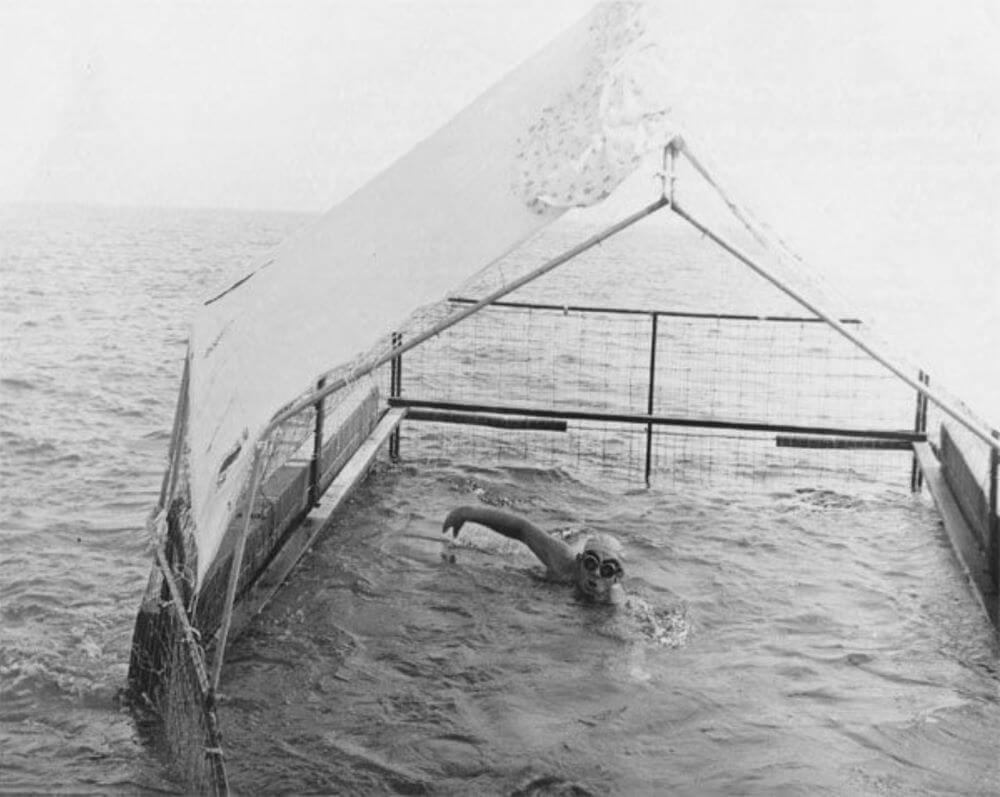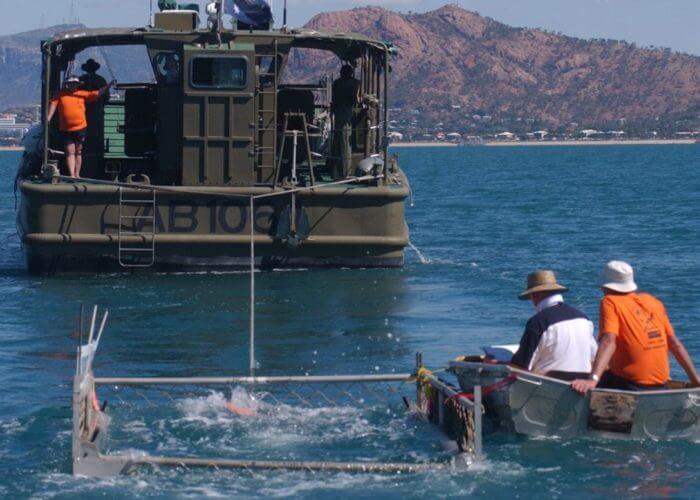Marathon Swimming in a Shark Cage: A Unique Way to Race in the Open Water

Marathon Swimming in a Shark Cage: A Unique Way to Race in the Open Water
You might ask: “Why would anyone knowingly swim in waters frequented by the more dangerous species of sharks (great white, bull and tiger to name just three)?” A silly question really as we witness: Free climbing El Capitan in Yosemite; Wingsuit flying; Bullriding; Ice swimming; and big wave surfing.
Some are simply drawn to events with higher risk and those with extra difficulty (a 109C dive – 4.5 somersault in tuck position; 200 butterfly; 400 individual medley; and a four-way English Channel swim over 132 km, taking 54 hours and 10 minutes).
There are then 3 reasons why a shark cage would be used for a marathon swim:
- The swimmer (or their family) insists.
- The crew insists. Over the last 50-plus years, there have been more than 20 fatalities during marathon swims, and the participating crew never really get over being part of a tragedy.
- The “Authorities” insist. These include: Governments (example Cuba); Coast Guard; Port Authorities; Ratification Authorities; Boat Pilots (covered by reluctant Insurance Companies); and Sponsors paying for a “good news story.”
The locations where shark cages were initially deployed included: Prince Philip Bay and Magnetic Island, the Florida Strait (between Cuba and Florida), Strait of Gibraltar and Papua New Guinea.
Interestingly, other swims in “sharky” locations typically happened without cages, such as off Rottnest Island, Devil’s Island, False Bay, the Farallon Islands and Hawaiian Channels.
Shark cages usually were constructed on demand with no set design. A good size was 24 feet in length, a width and below-water depth of eight feet and freeboard of two. The metal bars would be thick enough and closely spaced to stop an attack, but in hindsight they were not nearly as robust as the cages you see on television used for shark diving, which are nearly impenetrable.

Photo Courtesy: International Marathon Swimming Hall of Fame
The bottom and four sides would then be covered in a mesh fine enough to stop most jellyfish but big enough to allow water to freely pass. Ideally, the cage would not help the swimmer “draft,” but that was not easily done or proven. Over time, it became apparent that hundreds of stinging jellyfish coming to the surface during the night were more likely to stop a swim than sharks. Ocean Sevens swimmer Adam Walker managed to battle through major stings, but it is a major problem.
The cage needed a big door. Remember, the swimmer was not allowed to touch the cage. There was also a need for space for a crew to safely man the cage and operate the door, feed the swimmer and communicate with the escort boat. The cage needed floatation and was either towed or equipped with its own engines. The open sea is rough, so the cage needed to be durable. It seems that at least 10% of the cages “broke” before or during the swim, not a satisfying outcome after 30 miles of swimming!
International Marathon Swimming Hall of Fame Honorees were some of the original shark cage swimmers. Here are a few:
- Prince Philip Bay and Magnetic Island/Australia: Tamara Bruce; Richard “Dick” Campion; Melissa Cunningham; Christopher Guesdon; Chloë McCardel; Linda McGill, MBE; Des Renford, MBE; Penny Palfrey and Shelley Taylor-Smith.
- Florida Strait (Between Cuba and Florida): Christopher Green; Susie Maroney, OAM; Diana Nyad (First attempt) and Walter Poenisch.
- Strait of Gibraltar: Christopher Green; Mihir Sen and Dr. David Smith.
- Perhaps the longest swim ever completed was by Ersin Aydin in 43 hours from Turkey to Cyprus.
Melissa Cunningham, the 1994 25 km FINA world champion, describes the experience of shark-cage swimming as a challenge.
“Swimming in a shark cage is extremely difficult but exciting,” she said. “The team around you is important as your boat is in front so communication can be difficult. Before you start the race, you need to work out where your ‘sweet’ spot is in the cage. You then need to establish a pace, so the boat knows what speed to maintain. Too slow and you won’t win the race. Too fast and you get smashed to the back of the cage. Then the boat will need to slow down and work back to a new speed. Do this too many times and you’ll never find a rhythm. Then add in swell, you get slammed against all the walls. I’ve been lifted and landed on the top of the edges. I’ve chipped bones in my hand and had goggles smashed. Comparing your bruises the next day is all part of the fun!”
Penny Palfrey, the Queen of the Magnetic Island swim with 20 crossings mostly in cages, has also reflected on shark-cage swimming.
“I remember on one of my swims, I had a beautiful tow boat, but it had a nylon rope to tow my cage. With the weight of the cage and the force of pulling it through the water, the rope was like a big rubber band. It would stretch and stretch. While doing so, my cage was stationary and I was unable to swim anywhere. Then suddenly, the rope recoiled and I was sprinting at 50-meter pace. Then the process would begin over again!”
Shark cages are pretty much a thing of the past. They vanished as result of safety, the sport’s popularity, technology and a desire for “purity” of the sport. There were very few attacks on marathon swimmers so swims like Gibraltar saw three early swimmers in a cage and now 800-plus without.
The risks of debilitating jellyfish stings in the Caribbean and hypothermia up north were much higher than shark attacks. The crew reported to his wife that IMSHOF Honoree Ted Erikson died on a Farallon Island swim in 1966, but it wasn’t from a shark. It was due to hypothermia. He “came around” and a revised report was issued!
New technologies, including shark shields, are commonly available. These emit a pulse which, in theory, repels sharks. Drones are often now employed to allow crew to better observe possible shark activity and interest.
Finally, traditional marathon swimming is fiercely divided into two categories: Unassisted and assisted. Unassisted swimmers are generally allowed to have a normal swimsuit (no buoyancy), one cap (latex or silicone, not neoprene), ear plugs, a noseclip, goggles, a safety light, perhaps a few strips of medical tape, a shark shield, a drone and a sunscreen/grease/lubricant. They also can have a simple crew for watching and feeding.
Assisted swims include anything else, and this includes shark cages for several reasons. They can often allow the swimmer to “draft,” especially if the front is solid or near solid. They also tend to reduce the risk of being stung by jellyfish (which is part of the “normal” challenge. They often have a sun covering. Unless the depth is very deep, the swimmer will occasionally “rest” on the bottom depending on wave motion and there is often a distinct “dot” on the bottom of the cage to allow the swimmer to track.
Shark cages are a thing of the past and today there are many more global marathon swims annually where sharks still pose a danger. Safety remains the top priority and even the best-run events have issues.




coool
It’s incredible! Fascinating!
cool